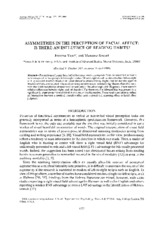| dc.creator | Vaid, Jyotsna | |
| dc.creator | Singh, Maharaj | |
| dc.date.accessioned | 2017-02-05T20:00:16Z | |
| dc.date.available | 2017-02-05T20:00:16Z | |
| dc.date.issued | 1989 | |
| dc.identifier.citation | Vaid, J. & Singh, M. (1989). Asymmetries in the perception of facial affect: Is there an influence of reading habits? Neuropsychologia, 27(10), 1277-1287. | en |
| dc.identifier.uri | https://hdl.handle.net/1969.1/158729 | |
| dc.description | Research study examining role of reading/writing direction in judgments of facial affect. | en |
| dc.description.abstract | Perceptions of happy facial effect from asymmetric composite faces presented in free vision were compared in four groups: left-to-right readers (Hindi), right-to-left readers (Arabic), left-to-right and right-to-left readers (Hindi/Urdu) and illiterates (Hindi/Urdu). Right - and left-handed users of Hindi and Urdu were studied. The analysis of asymmetry scores revealed a significant effect of Group, such that a left hemifield preference was present only in the left-to-right (Hindi) group. There were no reliable differences between right- and left-handers. Furthermore, the leftward bias was present in a significantly larger proportion of Hindi than Urdu or Arabic readers. These results are taken to reflect an interaction between a cerebral laterality effect and a directional scanning effect in facial affect judgment. | en |
| dc.language.iso | en | |
| dc.publisher | Elsevier | |
| dc.subject | facial affect judgment | en |
| dc.subject | reading direction biases | en |
| dc.subject | spatial biases in perception | en |
| dc.subject | chimeric faces | en |
| dc.subject | Urdu readers | en |
| dc.subject | Hindi readers | en |
| dc.subject | Arabic readers | en |
| dc.subject | Illiterate adults | en |
| dc.subject | scanning biases and brain lateralization | en |
| dc.subject | right hemisphere role | en |
| dc.subject | handedness | en |
| dc.subject | manual preference | en |
| dc.title | Asymmetries in the perception of facial affect: Is there an influence of reading habits? | en |
| dc.type | Article | en |
| local.department | Psychology | en |


